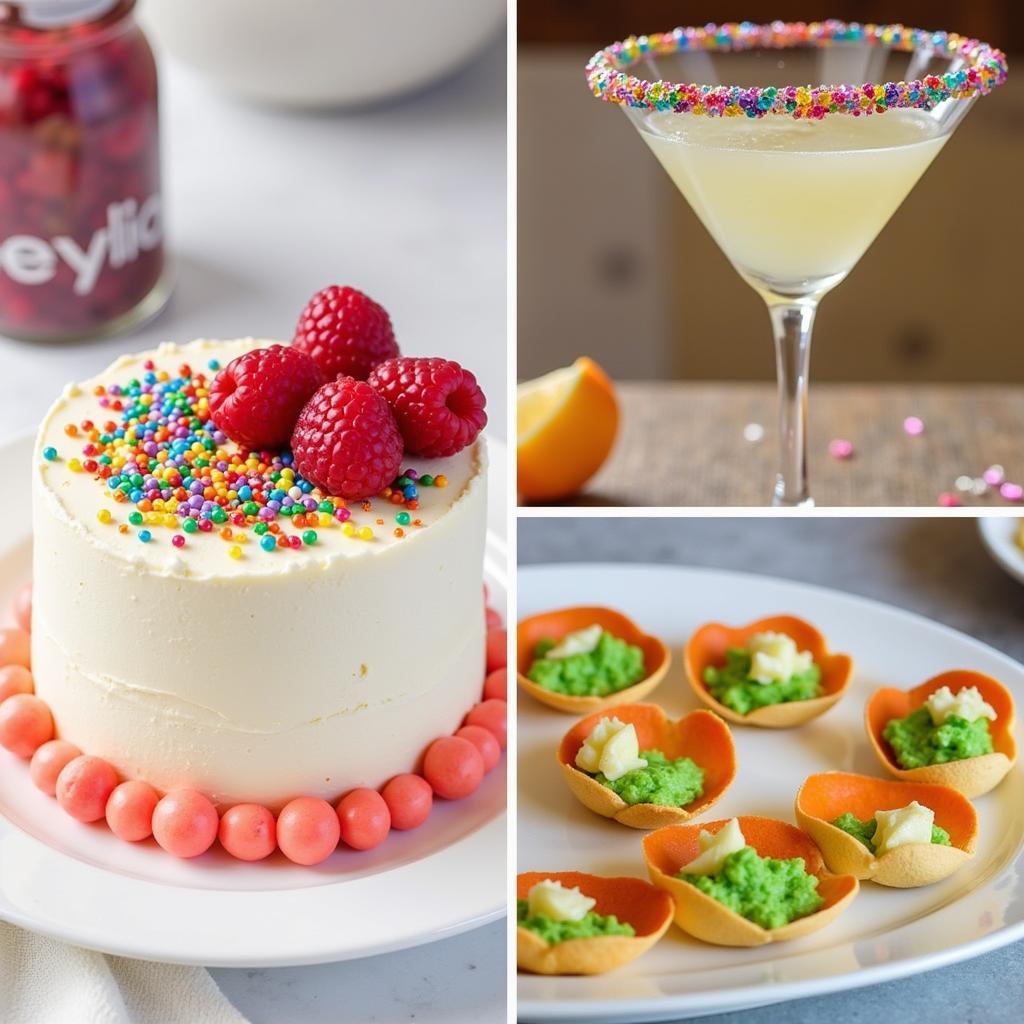Food Beads are tiny, colorful spheres that add a touch of whimsy and delight to culinary creations. From decorating cakes and cupcakes to adding a playful crunch to salads and desserts, these edible gems have taken the culinary world by storm. But what exactly are they, and how can you incorporate them into your cooking? Let’s dive into the fascinating world of food beads!
What Are Food Beads and How Are They Used?
Food beads, sometimes called pearl beads or caviar beads, are small, edible spheres made from a variety of ingredients. They come in a dazzling array of colors, sizes, and textures, offering endless possibilities for culinary experimentation. These tiny jewels can transform ordinary dishes into extraordinary works of art. Think of them as the edible equivalent of glitter, adding a touch of sparkle and fun to everything they touch. They can elevate a simple beads food presentation to something truly special.
Different Types of Food Beads
The most common type of food bead is made from seaweed extract, specifically sodium alginate. This gelling agent is combined with calcium chloride to create a thin, spherical membrane that encapsulates a flavorful liquid. These beads can be filled with fruit juices, vegetable purees, or even alcoholic beverages for a sophisticated twist. Other food beads are made from ingredients like tapioca starch, agar-agar, or even chocolate. This variety allows for a wide range of flavors and textures, from the classic “popping boba” used in bubble tea to delicate, melt-in-your-mouth chocolate pearls. Imagine the possibilities! You can even create miniature versions of your favorite foods using food for dollhouse.
 Examples of food beads used in various dishes like cakes, cocktails, and appetizers.
Examples of food beads used in various dishes like cakes, cocktails, and appetizers.
Making Food Beads at Home
While you can readily purchase food beads, making them at home can be a rewarding experience. It’s surprisingly easy, and it allows you to customize the flavors and colors to your liking. You can find numerous recipes online and even experiment with adding natural food coloring to create unique hues. Why not try making some felt food ornaments while you’re at it? It’s a fun and creative activity that can complement your culinary explorations.
Tools and Ingredients for Making Food Beads
You’ll need a few essential tools, including a syringe or pipette for dropping the alginate mixture into the calcium chloride bath, a slotted spoon for retrieving the formed beads, and a bowl for the calcium chloride solution. As for ingredients, sodium alginate, calcium chloride, and your chosen flavoring liquid are the basic building blocks.
Food Beads: More Than Just a Garnish
Food beads can be much more than just a decorative element. They can add an exciting textural dimension to your dishes, offering a burst of flavor with every bite. Imagine the delightful pop of a mango-filled bead in a summer salad or the subtle sweetness of a rosewater pearl atop a delicate dessert. The possibilities are endless!
“Food beads are a game-changer,” says renowned pastry chef, Amelia Dubois. “They not only add visual appeal but also a unique sensory experience that elevates any dish.”
Exploring Flavor Combinations
Don’t be afraid to experiment with different flavor combinations. Try pairing savory beads with meat dishes or incorporating spicy beads into a refreshing cocktail. For a festive touch, consider using brightly colored beads to decorate holiday treats. You could even store homemade food beads in glass baby food jars for a practical and charming solution.
“The beauty of food beads is their versatility,” says culinary innovator, Chef Marco Rossi. “They can be sweet, savory, spicy, or even alcoholic, making them a perfect addition to any culinary creation.”
Food Beads: A Culinary Adventure
Food beads are more than just a trendy ingredient; they represent a culinary adventure. They offer a unique way to explore flavors, textures, and visual presentation in your cooking. Whether you’re a seasoned chef or a home cook looking to add a touch of magic to your dishes, food beads are a must-try. Looking for inspiration? Try our free patterns felt food for some creative ideas.
In conclusion, food beads are a versatile and exciting ingredient that can transform ordinary dishes into culinary masterpieces. From their vibrant colors and unique textures to their endless flavor possibilities, food beads are a delightful addition to any kitchen. So, go ahead and explore the world of food beads, and let your culinary creativity shine!
FAQ
- Are food beads safe to eat? Yes, food beads made with approved food-grade ingredients are safe to consume.
- How long do food beads last? Homemade food beads should be consumed within a few days, while commercially produced beads may have a longer shelf life.
- Can I freeze food beads? Freezing can affect the texture of some food beads, so it’s best to consume them fresh.
- Where can I buy food beads? Food beads can be purchased online, at specialty food stores, and at some baking supply shops.
- What are some creative ways to use food beads? Consider using them in cocktails, desserts, salads, or even as a unique garnish for savory dishes.
For further assistance, please contact us at Phone Number: 02437655121, Email: minacones@gmail.com or visit us at 3PGH+8R9, ĐT70A, thôn Trung, Bắc Từ Liêm, Hà Nội, Việt Nam. We have a 24/7 customer service team.